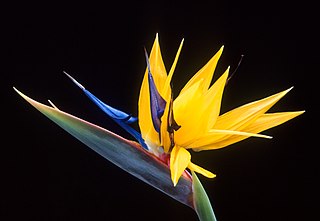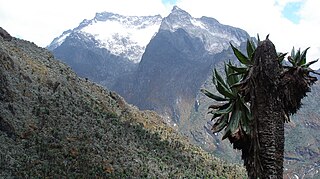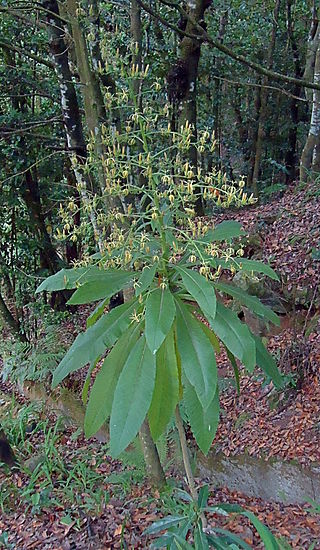
Saccharum is a genus of tall perennial plants of the broomsedge tribe within the grass family.

Strelitzia is a genus of five species of perennial plants, native to South Africa. It belongs to the plant family Strelitziaceae. A common name of the genus is bird of paradise flower/plant, because of a resemblance of its flowers to birds-of-paradise. In South Africa, it is commonly known as a crane flower.

Curtisia dentata is a flowering tree from Southern Africa. It is the sole species in genus Curtisia, which was originally classed as a type of "dogwood" (Cornaceae), but is now placed in its own unique family Curtisiaceae.

Coprosma is a genus of flowering plants in the family Rubiaceae. It is found in New Zealand, Hawaiian Islands, Borneo, Java, New Guinea, islands of the Pacific Ocean to Australia and the Juan Fernández Islands.

Vernonia is a genus of about 350 species of forbs and shrubs in the family Asteraceae. Some species are known as ironweed. Some species are edible and of economic value. They are known for having intense purple flowers. There have been numerous distinct subgenera and subsections named in this genus, and some botanists have divided the genus into several distinct genera. For instance, the Flora of North America recognizes only about twenty species in Vernoniasensu stricto, seventeen of which are in North America north of Mexico, with the others being found in South America.

Entandrophragma is a genus of eleven known species of deciduous trees in the family Meliaceae.

Deschampsia cespitosa, commonly known as tufted hairgrass or tussock grass, is a perennial tufted plant in the grass family Poaceae. Distribution of this species is widespread including the eastern and western coasts of North America, parts of South America, Eurasia and Australia.

Cyanthillium is a genus of tropical plants in the tribe Vernonieae within the family Asteraceae.

Habenaria, commonly called rein orchids or bog orchids, is a widely distributed genus of orchids in the tribe Orchideae. About 880 species of Habenaria have been formally described. They are native to every continent except Antarctica, growing in both tropical and subtropical zones.

Dendrosenecio adnivalis is one of the giant groundsels of the mountains of Eastern Africa. D. adnivalis grows on the Rwenzori Mountains and on the Virunga Mountains in Uganda and the Democratic Republic of Congo.

Asphodeline lutea is a perennial plant native to southeastern Europe, northern Africa, the Caucasus and the Levant. It is grown as a landscaping plant.

Pentanema squarrosum, known as ploughman's-spikenard, is a species of plant in the family Asteraceae found in Europe, North Africa, and the Near East.

Cyanthillium cinereum is a species of perennial plants in the sunflower family. The species is native to tropical Africa and to tropical Asia and has become naturalized in Australia, Mesoamerica, tropical South America, the West Indies, and the US State of Florida.
Hypericum pubescens is a perennial herb in the Hypericaceae family. It is in the section Adenosepalum.

Aloe dorotheae is a critically endangered succulent plant in the family Asphodelaceae. It is native to Tanzania.

Aloe volkensii is a species of plant widely distributed in East Africa.
Plants of the World Online (POWO) is an online database published by the Royal Botanic Gardens, Kew. It was launched in March 2017 with the ultimate aim being "to enable users to access information on all the world's known seed-bearing plants by 2020". The initial focus was on tropical African Floras, particularly Flora Zambesiaca, Flora of West Tropical Africa and Flora of Tropical East Africa.
Alysicarpus glumaceus is a plant in the legume family Fabaceae.

Musschia wollastonii is a species of flowering plant in the Campanulaceae family. It is endemic to Madeira Island.

Primula wollastonii, also known as Wollaston's primrose, is a species of flowering plant within the genus Primula and family Primulaceae. The species was first discovered and collected by A. F. Wollaston during an exhibition to Mount Everest in 1921. The plant would later be scientifically described by Scottish botanist Isaac Bayley Balfour, who named the species P.Wollastonii after a request from Wollaston who had first discovered it.
















